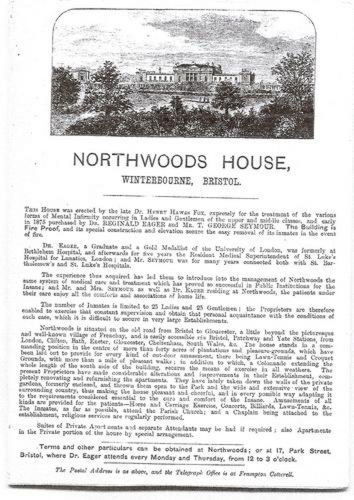
Introduction
Northwoods is a 19th-century parkland and ornamental woodland to an asylum. The building is in the style of a classical mansion and was built in 1832 for Edwin Fydell Fox. It is a copy of Brislington House, Bristol. Fox was a collector and hybridiser of British ferns from 1869 and helped build up the 'finest collection in the British isles' at Bristol Zoological Gardens. This record was checked with South Gloucestershire Historic Environment Records Officer - June 2010.
Northwoods is approached by a drive which passes between twin lodges of the same curious hacienda style as the adjoining Villa de France. Although these appear to be 1930s flat-roof constructions it is possible that they are much older. Research has so-far revealed no information. The house from the north and south-west retains its original appearance as one vast classical mansion which overlooks the falling ground. The drive climbs and curves around the back of the house. Land on either side retains a residual parkland character, with odd specimen oaks. Nearer the house there are also mature sequoia, cedars, Scots pines and yews. The drive sub-divides into six, one for each separate dwelling. In the central lawn stands a fountain, now not functioning but planted with bedding plants. It was formerly the central feature of the drive to Dr. E.C. Fox's asylum.
To the north is a small area of woodland composed of a mixture of indigenous species and exotics. This includes Scots pine, beech, ash, oak, horse chestnut, yew, aucuba, laurel, holly, bamboo and butcher's broom, under-planted with woodland bulbs. The rich ground flora would indicate a long history of woodland at this site. There are worked stones scattered around in the woods, apparently dumped by the builder who demolished the colonnade and connecting rooms between the main block of Northwoods and the two end pavilions. The margin of the wood adjacent to Northwoods House has specimens of gingko and weeping horse chestnut.
The garden area of Northwoods has been reduced to the woodlands and lawns flanking the drives to each house. To the east are allotments, although Northwoods House and Matford House have substantial gardens of their own. The woodlands are left to take care of themselves, and need some positive management. The lawns and private gardens are well-maintained. The former parkland is now under the control of a local farmer, who could perhaps take more care of the specimen trees and hedgerows on his land. The pastures to the west and east, which frame Northwoods, appear to suffer from a careless agricultural regime. Both areas have been subjects of numerous unsuccessful planning applications.
- Visitor Access, Directions & Contacts
- History
Little is known of the early history of Northwoods except that the name goes back at least to the 13th century. When the new manor of Frampton Cotterell was created the woodland was shared equally between Winterbourne and Frampton Cotterell.
'A portion of the Northwoods area, near the Old Gloucester Road, was included in Winterbourne although detached from the present civil parish. It has recently been transferred to the parish of Frampton Cotterell. Seyer (History of Bristol, chapter 34) says that William Wood possessed an estate in Winterbourne, around six miles from Bristol, called "Northwood". He was granted a patent by the king in 1723 to coin halfpence and farthings to the amount of £100,000 for use in Ireland. This was coined in Bristol. A great clamour was raised about "Wood's halfpence". The charges in connection with the transaction were investigated by the Privy Council and pronounced to be unfounded' (see references, Elliott, 1936).
The range of buildings at Northwoods, formerly one house, was built in 1832 for Dr. Edwin Fydell Fox as a purpose-built lunatic asylum. Dr. Fox was born in 1814, the son of Edward Long Fox who pioneered the humane treatment of the insane at Brislington House near Bristol. Tranquility, seclusion and extensive walks were fundamental to Fox's treatment. Brislington was developed as a country estate in parkland for the well-off but lunatic nobility.
Northwoods was clearly an extension by Dr. E.F. Fox of his father's work. Northwoods continued until 1948 as a privately-run mental asylum. It was then bought by Mr. Byrant of the neighbouring property, The Grange, and offered to Cheshire Homes, who declined it as unsuitable for their needs. The building fell into dereliction until it was bought by a local builder in the late 1950s / early 1960s. The builder demolished the colonnade, rather than restore it, and removed the ranges of rooms linking the end pavilions to the main block. The house also lost its balustraded parapet at this time. The resultant six houses are now privately occupied.
Edwin Fydell Fox became a collector and hybridiser of British ferns from 1869. Some of his ferns from Northwoods are said to be growing at Bristol Zoological and Botanical Garden.
- Associated People
- Features & Designations
Designations
The National Heritage List for England: Listed Building
- Reference: Northwoods
- Grade: II
Features
- Tree Feature
- Description: There is an ornamental woodland in the grounds.
- Fountain
- Earliest Date:
- Latest Date:
- Asylum (featured building)
- Now Apartments
- Earliest Date:
- Latest Date:
- Key Information
Type
Park
Purpose
Ornamental
Principal Building
Domestic / Residential
Survival
Extant
Hectares
8.1
Open to the public
Yes
Civil Parish
Frampton
- References
References
- {List of Buildings of Architectural and Historical Interest, County of Avon} List of Buildings of Architectural and Historical Interest, County of Avon
- Elliot, Charles Henry Babington {Winterbourne, Gloucestershire} (Bristol: St. Stephen's Bristol Press, 1936) Winterbourne, Gloucestershire
- Moore, John {Local History of Winterbourne, Frampton Cotterell and Stoke Giffard} Local History of Winterbourne, Frampton Cotterell and Stoke Giffard